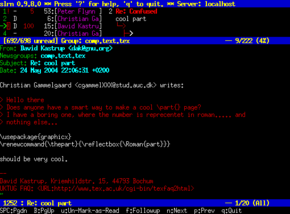Introduction and Usenet Structure
– Usenet was conceived in 1979 and established in 1980.
– It is one of the oldest computer network communication systems still in use.
– Usenet was built on the UUCP protocol and offered mail, file transfers, and news announcements.
– The name ‘Usenet’ was chosen to involve the USENIX organization.
– Articles posted on Usenet are organized into newsgroups and hierarchies.
– Newsgroups are categorized into topics and hierarchies.
– Users subscribe to newsgroups and track read articles.
– Articles in most newsgroups are responses to other articles.
– Threads are sets of articles connected to a single non-reply article.
– Modern newsreaders display articles in threaded and subthreaded formats.
Article Distribution and Usenet vs Other Media
– When a user posts an article, it is initially available on their news server.
– News servers exchange articles with each other through newsfeeds.
– Articles are copied from server to server until they reach every server in the network.
– Usenet operates on a sender-initiated transfer principle.
– Usenet was designed for slow and intermittent network connections.
– Usenet does not require personal registration or remote server storage.
– Archives of Usenet articles are always available.
– Usenet can be accessed using a news client, not a mail or web client.
– Usenet has diminished in importance compared to internet forums, blogs, and social media.
– Many newsgroups are now accessible through web browsers.
ISPs and News Servers
– Many ISPs and internet sites operate news servers.
– Some ISPs offer accounts from providers that specialize in newsfeeds.
– Newsreader client software is used to access Usenet servers.
– News servers are challenging to administer due to large data volumes and a small customer base.
– Not all ISPs run their own news servers.
Usenet and Email Clients
– Usenet was often accessed through email client programs.
– Integrated newsreaders were included in email client programs and internet suites.
– Newsgroup enthusiasts criticized integrated newsreaders as inferior.
– Email clients and internet suites were popular in the late 1990s and 2000s.
– Integrated newsreaders provided convenience for users.
Usenet and Operating Systems, Usenet and Newsgroup Enthusiasts
– Usenet was associated with the Unix operating system developed at AT&T.
– AT&T played a significant role in the development of Usenet.
– Usenet was initially used by AT&T employees and researchers.
– Usenet grew beyond AT&T and became widely used by the public.
– AT&T’s involvement in Usenet contributed to its early popularity.
– Newsreaders were developed for all major operating systems.
– Usenet was not limited to the Unix operating system.
– Users of different operating systems could access Usenet.
– The availability of newsreaders for various operating systems increased Usenet’s accessibility.
– Newsgroup enthusiasts had specific preferences for newsreaders.
– Integrated newsreaders were often criticized by newsgroup enthusiasts.
– Newsgroup enthusiasts valued the functionality and features of dedicated newsreader applications.
– Dedicated newsreaders were considered superior by newsgroup enthusiasts.
– The preferences of newsgroup enthusiasts influenced the development of newsreader applications.
Usenet (/ˈjuːznɛt/), USENET, or "in full", User's Network, is a worldwide distributed discussion system available on computers. It was developed from the general-purpose Unix-to-Unix Copy (UUCP) dial-up network architecture. Tom Truscott and Jim Ellis conceived the idea in 1979, and it was established in 1980. Users read and post messages (called articles or posts, and collectively termed news) to one or more topic categories, known as newsgroups. Usenet resembles a bulletin board system (BBS) in many respects and is the precursor to the Internet forums that have become widely used. Discussions are threaded, as with web forums and BBSes, though posts are stored on the server sequentially.


A major difference between a BBS or web message board and Usenet is the absence of a central server and dedicated administrator or hosting provider. Usenet is distributed among a large, constantly changing set of news servers that store and forward messages to one another via "news feeds". Individual users may read messages from and post to a local (or simply preferred) news server, which can be operated by anyone, and those posts will automatically be forwarded to any other news servers peered with the local one, while the local server will receive any news its peers have that it currently lacks. This results in the automatic proliferation of content posted by any user on any server to any other user subscribed to the same newsgroups on other servers.
As with BBSes and message boards, individual news servers or service providers are under no obligation to carry any specific content, and may refuse to do so for many reasons: a news server might attempt to control the spread of spam by refusing to accept or forward any posts that trigger spam filters, or a server without high-capacity data storage may refuse to carry any newsgroups used primarily for file sharing, limiting itself to discussion-oriented groups. However, unlike BBSes and web forums, the dispersed nature of Usenet usually permits users who are interested in receiving some content to access it simply by choosing to connect to news servers that carry the feeds they want.
Usenet is culturally and historically significant in the networked world, having given rise to, or popularized, many widely recognized concepts and terms such as "FAQ", "flame", "sockpuppet", and "spam". In the early 1990s, shortly before access to the Internet became commonly affordable, Usenet connections via Fidonet's dial-up BBS networks made long-distance or worldwide discussions and other communication widespread, not needing a server, just (local) telephone service.
The name Usenet comes from the term "users' network". The first Usenet group was NET.general, which quickly became net.general. The first commercial spam on Usenet was from immigration attorneys Canter and Siegel advertising green card services.
On the Internet, Usenet is transported via the Network News Transfer Protocol (NNTP) on TCP Port 119 for standard, unprotected connections and on TCP port 563 for SSL encrypted connections.
1912 NW 143rd Ave #24,
Portland, OR 97229, USA